Functional outcomes of all-inside arthroscopic anterior talofibular ligament repair with loop suture versus free-edge suture
- PMID: 36403066
- PMCID: PMC9675186
- DOI: 10.1186/s13018-022-03402-z
Functional outcomes of all-inside arthroscopic anterior talofibular ligament repair with loop suture versus free-edge suture
Abstract
Background: Anatomic repair of anterior talofibular ligament (ATFL) is used to manage chronic lateral ankle instability (CLAI). However, the optimal suture configuration used to repair the ATFL is not yet determined. It remains unclear whether suture configuration affects clinical outcomes in such patients.
Purpose: To compare the functional outcomes of all-inside arthroscopic ATFL repair using either a loop suture and or a free-edge suture configuration in CLAI patients.
Study design: Cohort study; Level of evidence, 3.
Methods: This retrospective cohort study included 71 patients with CLAI who had undergone an all-inside arthroscopic ATFL repair procedure with either loop suture (n = 36) or free-edge suture (n = 35) from February 2016 to July 2018. Comparable pre-operatively, the Visual analogy score (VAS), American Orthopedic Foot and Ankle Society scoring system (AOFAS), Karlsson Ankle Functional Score (KAFS) scoring system, Anterior Talar Translation (ATT) and Active Joint Position Sense (AJPS) were used to evaluate postoperative ankle function.
Results: There were no postoperative wound complications, implant reactions, or neurological or vascular injuries. Postoperative hospitalization, VAS, AOFAS, KAFS, AJPS and the time of return to sport were similar between the loop suture group and free-edge suture group. Requiring a longer procedure time, patients with loop suture configuration achieved better ATT.
Conclusion: All-inside arthroscopic ATFL repair procedure for CLAI treatment provides better ATT and comparable functional outcomes when a loop suture configuration is used instead of a free-edge suture configuration. A statistical difference in ATT was observed. Given the relatively short follow-up, it is questionable whether this will have any clinical relevance.
Keywords: Arthroscopic anterior talofibular ligament repair; Chronic lateral ankle instability; Free-edge suture; Loop suture.
© 2022. The Author(s).
Conflict of interest statement
None of the authors has any commercial associations or financial disclosures that might pose or create a conflict of interest with information presented in this article.
Figures





Similar articles
-
All-inside arthroscopic modified Broström-Gould procedure for chronic lateral ankle instability with and without anterior talofibular ligament remnant repair produced similar functional results.Knee Surg Sports Traumatol Arthrosc. 2021 Aug;29(8):2453-2461. doi: 10.1007/s00167-020-06361-2. Epub 2020 Nov 18. Knee Surg Sports Traumatol Arthrosc. 2021. PMID: 33206208 Free PMC article.
-
One double-loaded suture anchor is sufficient for all-inside arthroscopic anterior talofibular ligament repair.Knee Surg Sports Traumatol Arthrosc. 2023 Aug;31(8):3500-3508. doi: 10.1007/s00167-023-07348-5. Epub 2023 Feb 21. Knee Surg Sports Traumatol Arthrosc. 2023. PMID: 36810947
-
Functional Comparison of Horizontal Mattress Suture Versus Free-Edge Suture in the All-Inside Arthroscopic Broström-Gould Procedure for Chronic Lateral Ankle Instability.Orthop Surg. 2020 Dec;12(6):1799-1810. doi: 10.1111/os.12817. Epub 2020 Oct 18. Orthop Surg. 2020. PMID: 33073506 Free PMC article.
-
Is generalized ligamentous laxity a contraindication for a modified Broström operation to treat chronic lateral ankle instability? A systematic review.Foot Ankle Surg. 2021 Apr;27(3):271-277. doi: 10.1016/j.fas.2020.11.010. Epub 2020 Dec 2. Foot Ankle Surg. 2021. PMID: 33293241
-
Arthroscopic versus open repair of lateral ankle ligament for chronic lateral ankle instability: a meta-analysis.Knee Surg Sports Traumatol Arthrosc. 2020 May;28(5):1611-1618. doi: 10.1007/s00167-018-5100-6. Epub 2018 Aug 14. Knee Surg Sports Traumatol Arthrosc. 2020. PMID: 30109370
Cited by
-
All-inside arthroscopic procedures for chronic lateral ankle instability: evidence-based clinical practice guidelines.Br Med Bull. 2025 Apr 4;154(1):ldaf001. doi: 10.1093/bmb/ldaf001. Br Med Bull. 2025. PMID: 40183802 Free PMC article.
-
Two portals are sufficient for all-inside arthroscopic isolate anterior talofibular ligament repair.Arch Orthop Trauma Surg. 2025 May 24;145(1):316. doi: 10.1007/s00402-025-05927-4. Arch Orthop Trauma Surg. 2025. PMID: 40413275 Free PMC article.
-
Mid-term follow-up evaluation of a new arthroscopic Broström procedure for chronic lateral ankle instability.J Orthop Surg Res. 2023 Apr 24;18(1):316. doi: 10.1186/s13018-023-03789-3. J Orthop Surg Res. 2023. PMID: 37095551 Free PMC article.
References
-
- Ivins D. Acute ankle sprain: an update. Am Fam Phys. 2006;74:1714–1720. - PubMed
MeSH terms
Grants and funding
LinkOut - more resources
Full Text Sources

